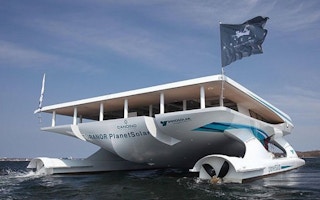A New Age catamaran laden with 38,000 solar cells and 8.5 tons of lithium batteries is headed for the final stretch of a world-first: circling the globe solely on sun power.
The MS Turanor, its rooftop of panels extended wide like wings with tapered twin hulls piercing the waves, pulled out of Mumbai’s port two days ahead of schedule this week on security and weather concerns. It’s off Pakistan today, heading toward the Strait of Hormuz, a chokepoint for one-fifth of the world’s traded oil supplies, as the vessel aims to finish its 25,000- mile circuit in Monaco by May.
The boat, which almost looks like a giant bird ready to take flight, has two motors that run quietly and electronically from the batteries. The Turanor is meant to show sun-powered travel is no dream, said its French skipper, Erwann Le Rouzic.
“The message isn’t to use only solar for everything but to use more of it,” Le Rouzic said. “People still think solar doesn’t work but we’re using it to go around the world.”
The catamaran and its SunPower Corp. crystalline panels have performed almost flawlessly, said Christian Ochsenbein, the engineer of the four-member crew. The panels, installed just as they would be on any building rooftop or solar park, haven’t been affected by salt or corrosion during their 14 months at sea, he said.
Immo Stroeher, owner of the 15 million-euro ($20 million) vessel who has served as a board member for German panel makers Q-Cells SE (QCE) and Solon SE (SOO1), says any commercial application for the multihull vessel that was built in Kiel, Germany, is secondary.
Fume-free travel?
Stroeher does see a market for silent, fume-free transport for water taxis, tourism in delicate ecosystems like the Galapagos Islands and Australia’s Great Barrier Reef, and for small-scale fishing vessels that don’t need to travel fast.
Renewable energy-powered transport in shipping, the sixth- largest source of greenhouse-gas emissions, accounting for almost 3 percent of carbon-dioxide discharges that contribute toclimate change, may not be as improbable as it sounds.
Tokyo-based Nippon Yusen, owner of the world’s second- largest fleet, is spending 70 billion yen ($901 million) over five years on emissions control. Its NYK Super Eco Ship 2030 could emit 69 percent less than existing carriers by using a combination of liquefied natural gas-powered fuel cells, sails and 31,000 square meters of solar panels, according to its website.
Lesson in efficiency?
Other shipping lines like A.P. Moeller-Maersk A/S and China Cosco Holdings Co. are cutting speeds and examining new designs to help reduce emissions ahead of new energy-efficiency rules that take effect in 2013. The United Nations’ shipping agency’s rules aim to slash carbon emissions from commercial ships in half by 2025.
The Turanor’s crew says navigating the boat is a lesson in efficiency. The lithium-ion batteries only store enough power for about 500 miles or three days of travel at about 10 knots. They’ve learned to adjust their speed and navigation to maximize the distance traveled with the amount of energy available.
“Our boat is like a very small planet,” says Ochsenbein. “If we spend too much, we run out and everything stops, the lights, the fridge, the navigation system. It’s the same with our world. If we use too much, it’ll be game over.”










